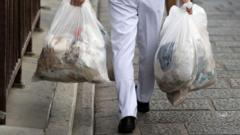Following the Fukushima disaster, local citizen scientists are stepping up to monitor radiation in their communities and provide critical information for residents.
Citizen Scientists Take Charge in Monitoring Fukushima's Fallout

Citizen Scientists Take Charge in Monitoring Fukushima's Fallout
Community members actively use scientific tools to measure radiation levels and regain control after the 2011 disaster.
As winter recedes in northern Japan, the village of Tsushima faces an ongoing challenge: invisible radiation from the notorious Fukushima nuclear disaster that unfolded in March 2011. In a remarkable grassroots initiative, local residents have taken it upon themselves to monitor radiation levels, utilizing measuring devices to reclaim their safety and well-being in a region forever altered by nuclear meltdowns.
Leading the charge is 72-year-old Tomoko Kobayashi, who insists that her annual checks have become crucial for her community. With a survey meter in hand— a device resembling a Geiger counter— Kobayashi ventures through familiar routes, stopping at various locations to gauge gamma rays and assess the radioactivity persistently plaguing the area following the failures at the Fukushima Daiichi nuclear plant.
Despite the government’s attempts to label the disaster as "over," Kobayashi and her group of devoted citizen scientists are determined to gather concrete data. Their approach involves taking readings from hundreds of points, which are then transformed into detailed, color-coded maps reflecting the level of radioactivity across the countryside. These maps are prominently displayed at Kobayashi’s historic family inn, Futabaya, providing essential information to guests and local residents.
The poignancy of their mission is underscored by Kobayashi's narrative. After the evacuation order was lifted, she reopened her inn, but the looming questions of safety linger—questions that could only be addressed through self-directed scientific inquiry. "I choose to live here, but is it safe?" she asks, emphatically conveying the necessity for direct measurement to ensure her family and neighbors can safely consume local foods.
Such citizen-led initiatives underscore a critical shift in monitoring responsibilities in Japan, demonstrating how communities can harness scientific tools to address public health concerns in the wake of bureaucratic uncertainty. They are stepping beyond passive acceptance of governmental declarations, placing their well-being squarely in their own hands, one measurement at a time.
Leading the charge is 72-year-old Tomoko Kobayashi, who insists that her annual checks have become crucial for her community. With a survey meter in hand— a device resembling a Geiger counter— Kobayashi ventures through familiar routes, stopping at various locations to gauge gamma rays and assess the radioactivity persistently plaguing the area following the failures at the Fukushima Daiichi nuclear plant.
Despite the government’s attempts to label the disaster as "over," Kobayashi and her group of devoted citizen scientists are determined to gather concrete data. Their approach involves taking readings from hundreds of points, which are then transformed into detailed, color-coded maps reflecting the level of radioactivity across the countryside. These maps are prominently displayed at Kobayashi’s historic family inn, Futabaya, providing essential information to guests and local residents.
The poignancy of their mission is underscored by Kobayashi's narrative. After the evacuation order was lifted, she reopened her inn, but the looming questions of safety linger—questions that could only be addressed through self-directed scientific inquiry. "I choose to live here, but is it safe?" she asks, emphatically conveying the necessity for direct measurement to ensure her family and neighbors can safely consume local foods.
Such citizen-led initiatives underscore a critical shift in monitoring responsibilities in Japan, demonstrating how communities can harness scientific tools to address public health concerns in the wake of bureaucratic uncertainty. They are stepping beyond passive acceptance of governmental declarations, placing their well-being squarely in their own hands, one measurement at a time.






